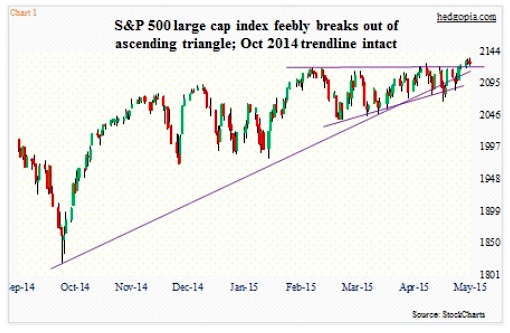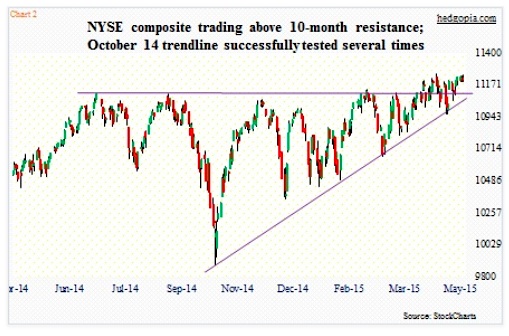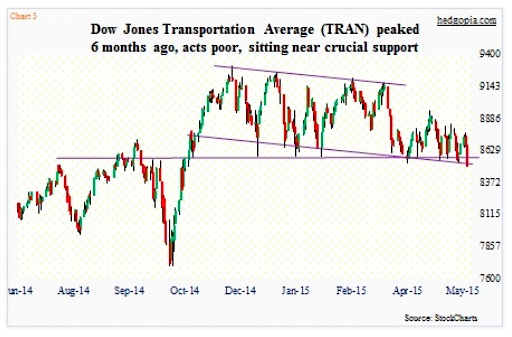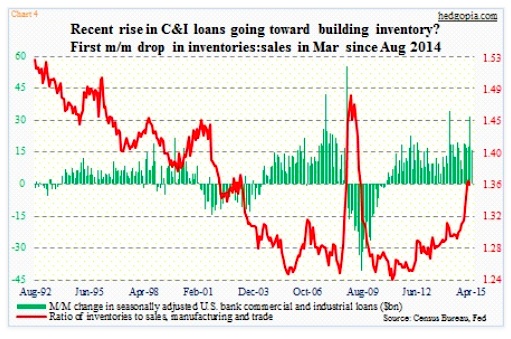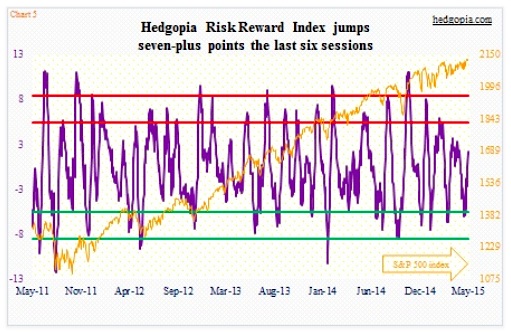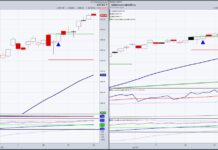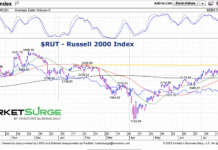Technicians and those technically inclined have waited with abated breath to see if the S&P 500 large cap index would hit 2138. That price marks the 161.8 Fibonacci extension of the October ’07 to March ’09 decline. For Fibonacci followers, this is an important sequence. That level was hit yesterday. Well, almost. Post-FOMC minutes, the intra-day high yesterday was 2134.72. Now that the Fib target has been hit, what next?
Here are a few high level thoughts with some charts and analysis:
- S&P 500 retraces 161.8 percent Fib extension of October ’07 to March ’09 decline
- Dow Transports not in sync with Dow/S&P 500, have broken several support levels
- Having spent lots of buying power of late, SPX shows signs of fatigue; pullback odds rising
S&P 500 Index
On the positive side of things, in order to get to 2138 the S&P 500 needed to push through a three-month range – out of an ascending triangle. That took place last Friday, though ever so slightly. On Monday, the index further built on that mini-breakout (see chart below). Under ideal circumstances, this could mean a measured-move target of 2200.
NYSE Composite Index
The NYSE composite is in tow. The 11000 level has been a ceiling since July last year. The index has now conquered that resistance. Plus, the index never lost its October 2014 trendline. It came close several times, but was saved each time (Chart 2). Some other major indices were not as lucky. The Russell 2000 small cap index, for instance, lost that trendline in the last week of April.
For nitpickers, when the S&P 500 nudged past the aforementioned resistance on Friday, it took place without much fanfare. Ditto with the further progress made on Monday. In fact, volume on Monday was lighter than in the previous two sessions. Not what you prefer to see in the midst of a breakout. On both Tuesday and Wednesday, the index nudged lower – essentially flat – and volume picked up.
What is going on here?
After a breakout, it is not at all surprising to see an index go sideways and try to digest the gains. It is normal.
What is not normal is what is happening elsewhere.
Dow Jones Transportation Average
Forget the hit airline stocks took yesterday. Transports have refused to go along for the Dow Industrials/S&P 500 ride for six months now. The Dow Jones Transportation Average peaked toward the end of November last year and has traced out a lower-highs-lower-lows pattern. Yesterday, it fell out of that channel, though barely, so there is still time to retake that. It has, however, lost a major horizontal support level (see chart below). The index is now under both 50- and 200-day moving averages.
If industrials are doing just fine, but transports are struggling, markets are not in sync. Something is missing in the hunky-dory picture. Things are being produced but they are not being transported around because (1) there is not enough demand out there, and/or (2) shelves are full. Makes you wonder, is that why inventories have been rising?
U.S. Commercial & Industrial Loans
The next chart looks at month-over-month change in U.S. commercial and industrial loans against the ratio of inventories to sales. For over a year now, the green bars have seen an uptick. But so has the red line, which has been rising since last August.
This weakness is not just limited to the transports. Utilities peaked in January. Both the Russell 2000 and the Nasdaq 100 are below their respective April highs. The shining light in all this is how financials are behaving. The SPDR Financial Sector ETF (XLF) on both Tuesday and Wednesday retreated a bit after testing late-December high of $25.05. On the other hand, the SPDR S&P Bank ETF (KBE) broke out two weeks ago.
The financials must have expended a lot of buying power doing that. This also applies to the S&P 500. And this is where it gets tricky.
Fund-flow news of late has been anything but positive. U.S. stock funds have seen $100 billion in redemptions this year. A Bank of America Merrill Lynch survey of global fund managers showed the other day that they only held 4.5 percent of assets in cash.
Stock Market Risk-Reward
All this and yet the S&P 500 Index is hanging in there. But signs of fatigue are showing up, with dojis the last two sessions, raising the odds for a pullback near-term. The Hedgopia Risk Reward Index still has room to move higher before getting to the red zone, but this thing has gained seven-plus points the last six sessions.
Key technical levels to watch in the markets: SPX (2117, followed by 2095); RUT (1215); NDX (4480); NYA (11100); DOW (18200).
Thanks for reading.
Read more on Paban’s blog Hedgopia.
Twitter: @hedgopia
No position in any of the mentioned securities at the time of publication. Any opinions expressed herein are solely those of the author, and do not in any way represent the views or opinions of any other person or entity.
ALSO READ: Market Set To Test S&P 500 Major Fibonacci Extension Level

